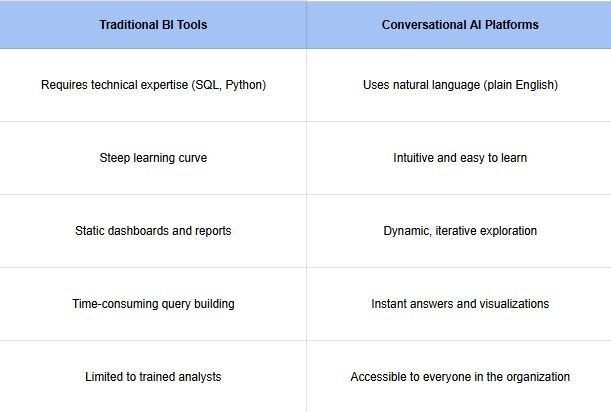July 15th, 2025
How Conversational AI Simplifies Data Analysis for Everyone
By Laura Clugston · 3 min read

Data has become the lifeblood of modern business, but accessing its insights has traditionally been reserved for those with specialized skills. Data scientists, analysts, and programmers who could write complex SQL queries or Python scripts were the gatekeepers of information. Today, that barrier is crumbling thanks to a transformative technology: Conversational AI.
Often discussed in the context of "ChatGPT for data analysis," these advanced AI systems are fundamentally changing our relationship with data. They allow anyone, regardless of their technical background, to ask questions in plain English and receive sophisticated analyses, visualizations, and insights in return. The global conversational AI market is projected to grow from $12.24 billion in 2024 to $61.69 billion by 2032, signaling a massive shift in how we work [1].
This article explores how conversational AI is democratizing data analysis, making it an intuitive, efficient, and accessible tool for everyone.
What is Conversational AI in Data Analysis?
Conversational AI for data analysis refers to platforms that use artificial intelligence, particularly Natural Language Processing (NLP) and machine learning, to understand and respond to user requests made in everyday language. Instead of writing code, users can simply "talk" to their data.
Think of it as having a data analyst on call 24/7. You can upload a spreadsheet and ask:

The AI interprets your intent, performs the necessary calculations, and generates the requested visualization without you needing to touch a single line of code. These platforms are designed to handle the entire exploratory data analysis (EDA) process, from cleaning data to identifying trends, anomalies, and correlations automatically [2].
The Business Impact: A Rapidly Adopted Revolution
The move towards conversational interfaces is not a niche trend; it's a widespread business revolution. Companies are rapidly integrating this technology to enhance efficiency and customer experience.
• Widespread Adoption: As of 2025, 78% of companies have already integrated conversational AI into at least one key operational area, with the majority reporting improved efficiency and steady returns [3].
• Customer Service Transformation: The impact is especially profound in customer service. Today, an estimated 80% of call centers are leveraging AI-powered technologies to shift from reactive problem-solving to proactive customer support through real-time analytics and sentiment analysis [4].
• Massive Investment: The market is forecast to generate $57 billion in revenue globally between 2025 and 2029, driven by enterprise demand for more efficient and intelligent systems [5].
This rapid adoption underscores a simple truth: conversational AI delivers tangible value by making complex processes simpler and more intuitive.
Key Benefits of Conversational Data Analysis
The shift from complex dashboards to simple conversations offers powerful advantages for individuals and organizations.

Democratizing Data for Everyone
The most significant benefit is the democratization of data. Conversational AI empowers non-technical users—from marketing managers and sales leaders to HR professionals—to directly query datasets and derive their own insights. This breaks down information silos and fosters a more data-driven culture across an entire organization [2].
Boosting Productivity and Efficiency
By automating routine and repetitive tasks, conversational AI frees up valuable time for both technical and non-technical staff. Analysts can automate tedious data cleaning and preliminary exploration, while business users can get instant answers without waiting in a queue for the data team. This automation enhances overall employee productivity and allows teams to focus on strategic, high-impact work [6].
Enabling Iterative, Context-Aware Exploration
Data analysis is rarely a one-question process. It’s a conversation. Modern conversational AI tools excel at this by maintaining context throughout an interaction.
You can ask a follow-up question like, "Okay, now break that down by region," and the AI understands you're referring to the previous query. This allows for a fluid, iterative exploration that mimics a natural conversation with a human analyst, helping users dig deeper into the data layer by layer [2].
The Rise of Specialized Tools for Data Analysis
While general-purpose models like ChatGPT can perform basic data analysis, the real power lies in specialized platforms built from the ground up for this purpose. These tools offer more robust, secure, and integrated experiences tailored to the complexities of data work. They connect directly to data sources, handle larger datasets, and provide a suite of tools specifically for analysis and visualization.
For instance, platforms like Julius AI are engineered specifically for this purpose. Recognized among the top AI chatbots for exploratory data analysis, Julius facilitates natural language data exploration, supports context-aware conversations, and can automatically generate insights and visualizations. By focusing exclusively on analysis, tools like Julius effectively lower the barrier to entry for complex data tasks, making them accessible to a broader audience of knowledge workers and streamlining the workflow for seasoned data scientists [2].
The Future is Conversational
The trajectory is clear: the future of data analysis is conversational. As AI technology advances, these tools will become even more proactive and "agentic," capable of anticipating user needs and surfacing critical insights before they are even requested.
The ability to simply ask a question and get a data-backed answer is no longer a futuristic concept. It's a present-day reality that is empowering smarter, faster, and more inclusive decision-making for businesses of all sizes.
Frequently Asked Questions (FAQs)
What is conversational AI for data analysis?
Conversational AI is a technology that allows users to analyze data by asking questions in natural language (like English) instead of writing code. The AI interprets the request, performs the analysis, and provides answers, charts, and insights.
Can I use ChatGPT for data analysis?
Yes, you can use general models like ChatGPT for basic data analysis tasks. However, specialized platforms are often more powerful and secure for business use. They are designed to handle larger datasets, maintain conversational context more effectively, and offer a wider range of analysis and visualization tools.
What are the main benefits of using a conversational AI tool for data?
The key benefits of using a conversational AI tool for data include accessibility (making data analysis available to non-technical users), efficiency (automating tedious tasks and providing instant answers), and deeper insights (facilitating exploration to uncover more detail).
Do I need to know how to code to use these tools?
No, you don’t need to know code to use data analysis tools. The primary advantage of conversational AI for data analysis is that it eliminates the need for coding knowledge. Users interact with the system using plain language, making it accessible to everyone.
